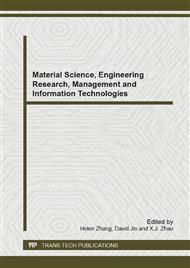[1]
J. Zheng, J. Hu, C. B. Ke, Z. Q. Huang. Integrated modular avionics software system testing methods research summary. Computer Applications and Software, 2012: 29(5): 163-168. (in Chinese).
Google Scholar
[2]
H. G. Xiong, Z. H. Wang. Advanced avionics integration technologies. Beijing: National Defence Industry Press. 2009: 14-15. (in Chinese).
Google Scholar
[3]
RTCA DO-297. Integrated modular avionics (IMA) development guidance and certification considerations. Washington D.C.: Radio Technical Commission for Aeronautics. Inc (RCTA), (2005).
DOI: 10.1201/9781315222233-14
Google Scholar
[4]
RTCA DO-178B. Software considerations in airborne systems and equipment certification. Washington D.C.: Radio Technical Commission for Aeronautics. Inc (RTCA), (1992).
Google Scholar
[5]
X. G. Xu, H. Ye. The design and implementation of inter-partition communication in avionics systems. Aeronautical Computer Technique,2005, 31(1): 45-047. (in Chinese).
Google Scholar
[6]
W. K. Chu, F. M. Zhang, X. G. Fan. Overview on software architecture of integrated modular avionic system. Acta Aeronautica et Astronautica Sinica, 2009, 30(10): 1912-1917. (in Chinese).
Google Scholar
[7]
Q. Zhou,B. Liu,Z. W. Yu,S. Y. Feng. A framework of simulation testing environment for integrated modular avionics software. Acta Aeronautica et Astronautica Sinica. 2012. 33(4): 722-733. (in Chinese).
Google Scholar
[8]
C. H. Zheng, X. Z. Chen, X. X. Zhang. Reliability design of integrated modular avionics system. Computer Engineering, 2009, 35(23): 272-277. (in Chinese).
Google Scholar
[9]
J. Chen. Application of ARINC653 partition operation system in integrated modular avionics(IMA) system. Telecommunication Engineering, 2009, 49(5): 89-92. (in Chinese).
Google Scholar
[10]
A. Rountev, S. Kagan, J. Sawin. Coverage criteria for testing of object interactions in sequence diagram. Fundamental Approaches to Software Engineering, 2005, Lecture Nodes in Computer Science, 3442, Springer-Verlag, pp.289-304.
DOI: 10.1007/978-3-540-31984-9_22
Google Scholar
[11]
M. Sharir, A. Pnueli. Two approaches to interprocedural data flow analysis. Muchnick S, Jones N. Program Flow Analysis: Theory and Applications. Prentice Hall, 1981: 189-234.
Google Scholar
[12]
G. Ammons, T. Ball, J. Larus. Exploiting hardware performance counters with flow and context sensitive profiling. ACM SIGSOFT Conference on Programming Language Design and Implementation. 1997: 85-96.
DOI: 10.1145/258915.258924
Google Scholar
[13]
Y. K. Dong, C. H. Li. Approach to generate integration test sequence based on UML collaboration diagrams. Computer Engineering and Applications, 2007, 43(5): 96-98. (in Chinese).
Google Scholar


